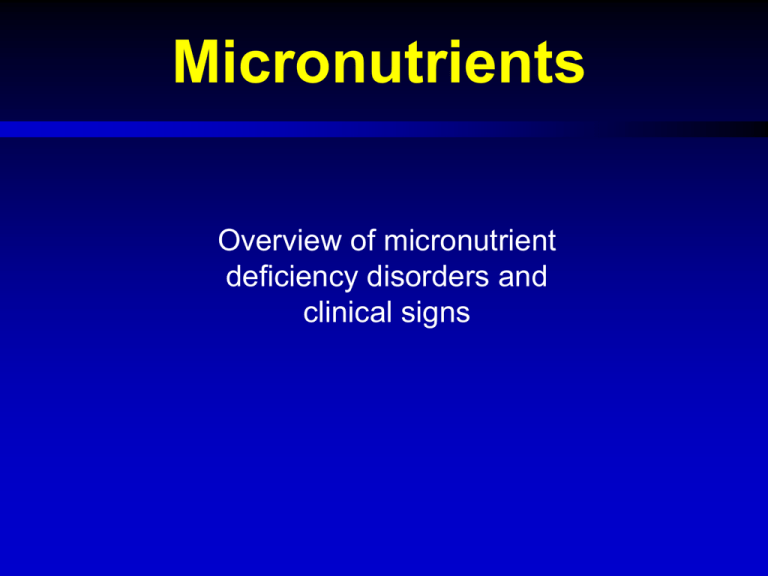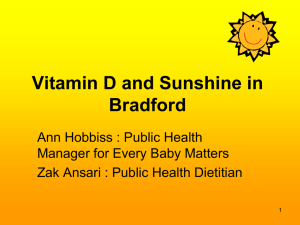Overview of micronutrient deficiency disorders and clinical signs
advertisement

Micronutrients Overview of micronutrient deficiency disorders and clinical signs Objectives Overview of major micronutrient deficiencies • • • • Iron Iodine Vitamin A Zinc Clinical features Biochemical assessment Treatment Micronutrient deficiencies in emergencies What is Malnutrition? Malnutrition = “lack of nutrients / poor nutrition” Two principle constituents: • Protein-energy malnutrition • Deficiency in micronutrients Zinc Vitamin D Riboflavin Thiamin Vitamin E Magnesium Iodine Vitamin B6 Manganese Folate Iron Vitamin B12 Vitamin A Vitamin C Cobalt Phosphorus Cobalamin Seleniu m Niacin Vitamin K Chromium Micronutrient deficiencies are common throughout the world including in most emergency-affected populations…. Overview of Micronutrient Deficiencies Common when dependent on relief food Preventable, BUT • Food sources not common and are expensive • Fortification adds to cost of relief food Difficult to recognize • Symptomatic cases often represent tip of iceberg • Laboratory assessment difficult & expensive Lack of 1 micronutrient typically associated with deficiencies of other micronutrients Highest risk groups • Young children • Pregnant Women • Lactating women 4 Major Micronutrient Deficiencies Iron Anemia Iodine Iodine Deficiency Disorders (IDD) Vitamin Zinc A Xeropthalmia Multiple disorders Anemia Most common global nutrition problem Common causes of anemia • Iron deficiency anemia (IDA) • Infections (malaria, hookworm, HIV) • Other vitamin deficiencies • Hemoglobinopathies Health impact • Perinatal & maternal mortality • Delayed child development • Reduced work capacity Anemia- Risk Factors •Low dietary intakes • Diet poor in iron-rich foods/animal foods • High intake of inhibitors (Tea) • Infections (malaria, helminthes infection, schistosomiasis) • Blood loss Anemia- Signs & Symptoms Tiredness and fatigue Headache and breathlessness Pallor: pale conjunctivae, palms, tongue, lips and skin Anemia- Assessment Blood can be tested for anaemia using different methods which look at the colour of the blood, the number of blood cells, or use a chemical which reacts with the haemoglobin. • • Hemoglogin (Hemocue) Hematocrit Defined by WHO as: • Hb <11.0 g/dL – children • Hb <12.0 g/dL – women • Hb <12.0 g/dL - Men Soluble transferrin receptor (sTfR) Ferritin (FER) Iron (Fe) and total iron binding capacity (TIBC) Zinc protoporphyrin (ZP) Hemoglobin (Hb) Lab Field Price, Complexity of Test Indicators of Iron Status Anemia- Treatment Dietary diversification • Foods that are rich in iron include: • Meat • Fortified cereals • Spinach • Cashew nuts • Lentils and beans Fortification Iron supplements Iodine Deficiency Disorders (IDD) Significant cause of preventable brain damage in children Health effects: • Increased perinatal mortality • Mental retardation • Growth retardation Preventable by consumption of adequately iodized salt Iodine Deficiency Affects the Brain Cretinism Goiter Reduced intellectual performance *Goiter manifests only a small portion of IDD IDD- Risk Factors Low iodine level in food • products grown on iodine-poor soil – – erosion, floods mountainous areas • distance from sea (low fish intake) Non-availability of iodized food (salt) IDD- Assessment Measure urinary iodine excretion (UIE) Measure levels of thyroid hormones in blood Measure degree of goitre Grade 0 Grade 1 Grade 2 No Goitre Palpable Goitre Visible Goitre Titration Lab Gold standard WYD Iodine Checker Single wavelength (585 nm) spectrophotometer Measures iodine level (ppm) in salt based on the absorption of the iodine-starch blue compound Rapid Kit Qualitatively measures iodine content in salt Highly sensitive but not specific Inexpensive Field Price, Complexity of Test Salt Iodine Measurement Vitamin A Deficiency (VAD) Leading cause of preventable blindness among pre-school children Also affects school age children and pregnant women Weakens the immune system and increases clinical severity and mortality risk from measles and diarrhoea Supplementation with vitamin A capsules can reduce child mortality by 23%. WHO (2002) estimates that 21% of all children suffer from VAD, mostly in Africa and Asia VAD- Signs & Symptoms Clinical deficiency is defined by: • night blindness • Bitot’s spots • corneal xerosis and/ or ulcerations • corneal scars caused by xerophthalmia WHO Classification of Xerophthalmia 1N Night blindness 2B Bitot’s spots X3 Corneal xerosis 2B X3 X4 Corneal ulcerations Keratomalacia X5 Corneal scars - permanent blindness X4 X5 VAD- Risk Factors • Low availability of vitamin A-rich foods • Lack of breastfeeding • High rates of infection (measles, diarrhoea) • Malnutrition VAD - Assessment Clinical assessment for night blindness Biochemical assessment • Retinol • • Serum analyzed by HPLC Cutoff: < 0.7 µmol/L • Retinol-binding protein (RBP) • • Serum or DBS analyzed by ELISA Cutoff: ~ < 0.7 µmol/L Dried Blood Spots for RBP Quick and easy field friendly technique Collection through venipuncture or finger stick Fasting not necessary DBS should completely dry and be protected from humidity Storage of DBS at –20oC only for short term, –70oC for long term Shipping of DBS cards on frozen ice packs to the laboratory Poor Quality DBS VAD- Treatment Supplementation • Capsules given during immunization days Food Forms • As pre-formed vitamin A in foods from animals • Liver, fish • As pro-vitamin A in some plant foods • • red palm oil, carrots, yellow maize Fortified blended foods (CSB or WSB) High dose oral supplements of vitamin A Rapid and targeted Highly effective in lowering mortality in infants and children in third world communities Highly effective in reducing complications in measles Reduced prevalence of malaria in children in Papua New Guinea Zinc Deficiency Zinc essential for the function of many enzymes and metabolic processes Zinc deficiency is common in developing countries with high mortality Zinc commonly the most deficient nutrient in complementary food mixtures fed to infants during weaning Zinc interventions are among those proposed to help reduce child deaths globally by 63% (Lancet, 2003) Zinc Deficiency- Signs & Symptoms Hair loss Skin lesions Diarrhea Poor growth Acrodermatitis enteropathica Death Zinc Deficiency- Assessment No simple, quantitative biochemical test of zinc status Serum Zinc • • • Can fluctuate as much as 20% in 24-hour period Levels decreased during acute infections Expensive Hair zinc analysis Zinc Deficiency- Treatment Regular zinc supplements can greatly reduce common infant morbidities in developing countries • Adjunct treatment of diarrhea 20mg /day x 10 days • • Pneumonia Stunting Zinc deficiency commonly coexists with other micronutrient deficiencies including iron, making single supplements inappropriate Dietary diversification • Animal protein (oysters, red meat) Zinc Vitamin D Riboflavin Thiamin Vitamin E Magnesium Iodine Vitamin B6 Manganese Folate Iron Vitamin B12 Vitamin A Vitamin C Cobalt Phosphorus Cobalamin Seleniu m Niacin Vitamin K Chromium What do the micronutrients in red have in common? Micronutrient deficiencies in emergencies Deficiencies of: Vitamin C scurvy Niacin (vitamin B3) pellagra Thiamin (vitamin B1) beriberi …usually associated with situations where populations are fully dependent on limited commodities for their food needs. Vitamin C - Ascorbic Acid Humans are among the few species that cannot synthesize vitamin C and must obtain it from food Manufacture of collagen • Helps support and protect blood vessels, bones, joints, organs and muscles • Protective barrier against infection and disease • Promotes healing of wounds, fractures and bruises Sources • Citrus fruits, strawberries, kiwifruit, blackcurrants, papaya, and vegetables Scurvy – Signs & Symptoms Small blood vessels fragile Gums reddened and bleed easily Teeth loose Joint pains Dry scaly skin lower wound-healing, increased susceptibility to infections, and defects in bone development in children Thiamin – Vitamin B1 What it does in the body • energy production and carbohydrate and fatty acid metabolism • vital for normal development, growth, reproduction, healthy skin and hair, blood production and immune function Deficiency due to diets of polished rice Beri Beri- Signs & Symptoms Develop within 12 weeks Dry Beriberi peripheral neuropathy • Difficulty walking and paralysis of the legs • Reduced knee jerk and other tendon reflexes, foot and wrist drop • Progressive, severe weakness and wasting of muscles Wet Beriberi cardiopathy • Edema of legs, trunk and face • Congestive heart failure (cause of death) Wrist & foot drop: Dry Beri Beri Edema: Wet Beri Beri Riboflavin Deficiency Deficiency is rare and often occurs with other B vitamin deficiencies Several months for symptoms to occur • Burning, itching of eyes • Angular stomatitis • Cheilosis • Swelling and shallow ulcerations of lips • Glossitis Riboflavin deficiency Angular stomatitis Glossitis Niacin – Vitamin B3 Essential for healthy skin, tongue, digestive tract tissues, and RBC formation Processing of grains removes most of their niacin content so flour is enriched with the vitamin Pellagra – Signs & Symptoms ‘three Ds’: diarrhea, dermatitis and dementia Reddish skin rash on the face, hands and feet which becomes rough and dark when exposed to sunlight (pellagrous dermatosis) • acute: red, swollen with itching, cracking, burning, and exudate • chronic: dry, rough, thickened and scaly with brown pigmentation dementia, tremors, irritability, anxiety, confusion and depression Pellagra Dermatitis Summary Major risk factors for micronutrient deficiency diseases include poor dietary intake, infection, disease and sanitation The 4 major MDD are anemia, iodine deficiency, vitamin A deficiency, and zinc deficiency Treatment for MDD include dietary diversification, supplementation, and food fortification






